Alex Taylor,BBC News Culture reporter, @Tayloredword
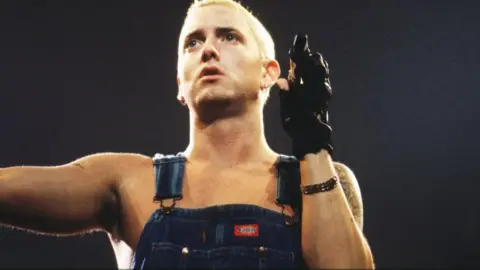 Getty Images
Getty Images
Twenty-five years after bursting on to the scene, it appears rapper Eminem’s provocative alter ego Slim Shady may finally be silenced.
The antagonistic Slim Shady, with his peroxide-blond hair and everyman blue jeans, stemmed from Eminem’s self-described “white trash” upbringing.
In a surprise April announcement teased as a mock murder news report, Eminem revealed that his new album, The Death of Slim Shady (Coup de Grâce), will be released this summer.
And on Friday, Shady once again said “guess who’s back” – reappearing to cause havoc on the album’s lead single, Houdini.
Featuring cameos from rap icons Dr Dre, Snoop Dogg and 50 Cent as well as comics Pete Davidson and Shane Gillis, Eminem comes face-to-face with the rap anti-hero he created.
The new album title suggests a fittingly violent end to Slim Shady, with the rapper himself concluding: “I knew it was only a matter of time.”
So, as his alter ego rises to his feet for the last time – how should we understand his legacy?
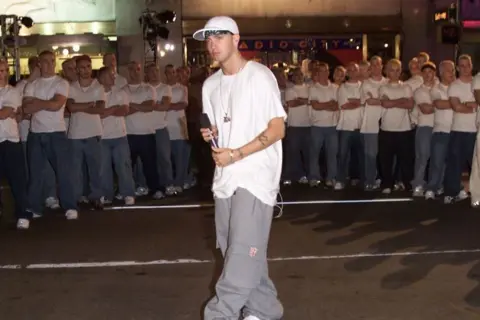 Getty Images
Getty Images
Born Marshall Mathers III, Eminem was raised in Michigan’s low-income, majority-black Detroit neighbourhoods.
Rap became an escape when he was a teenager, from a childhood of strained parental relationships and bullying.
He tried to break into the music scene, and felt “crushed” when Vanilla Ice became the face of white solo rap in 1990, his pop-party track Ice Ice Baby selling millions.
“Ice’s name became synonymous with selling out and manufactured success,” surmised The Ringer’s Justin Sayles.
But Mathers was different, “a true product of ghetto streets,” wrote Nick Hasted in his Eminem biography.
This left him uniquely placed to manage what Jeff Weiss called the “cultural debt” faced by white rap artists.
It helped that his flow, honed through years of rap battles, was spectacular.
Prof Anthony Kwame Harrison, a sociologist specialising in hip-hop, praised Eminem’s skills, saying “his outstanding rhyming and songcraft made him the last white rap pioneer”.
Despite this, his 1996 album, Infinite, failed to attract major labels.
His early mentors, the Bass Brothers, suggested the idea of “shock-rap”, which led to the birth of Slim Shady.
“The market didn’t take to it until he got a little foul-mouthed,” added Mark Bass.
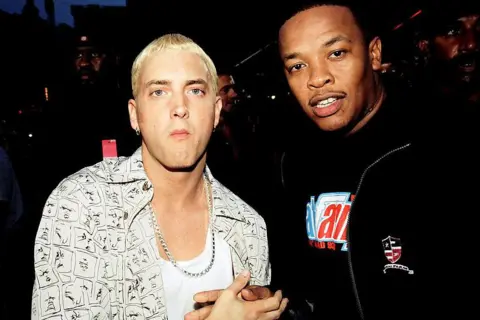 Getty Images
Getty Images
The resulting Slim Shady EP found its way to mogul Jimmy Iovine and NWA rap royalty Dr Dre, who immediately signed Eminem to Interscope.
Dre discovered in Slim Shady an anti-hero. Eminem’s crossover appeal from Dre’s co-sign was cemented with features alongside respected black rappers.
Their production partnership may have bridged some of rap’s racial divides but, in unleashing 1999’s Slim Shady LP on an unsuspecting public, also spawned contradictions in Slim Shady and Eminem’s legacy that persist to this day.
‘White hot’
Eminem’s arrival as Slim Shady on the lead single, My Name Is, was timed perfectly for chaotic impact. While America reportedly enjoyed its “happiest decade” during the 90s, Shady revealed a disillusioned white underbelly.
The Slim Shady LP sold 500,000 copies in two weeks and earned two of Eminem’s 15 Grammys. It was the last time an Eminem record didn’t debut at number one.
The chart-topping Marshall Mathers LP released just a year later took aim at outraged parents, politicians, and societal hypocrisy. Shady revelled in outraging prim white suburbia, crudely proclaiming unspoken truths. “There’s a million of us just like me… who cuss like me,” he spat.
A 2000 MTV performance of the track saw Shady lead an army of lookalikes into the auditorium, goading critics.
Rolling Stone declared he had gone from “white trash to white hot”.
‘The kids get the joke’
But despite his success, controversy over his lyrics’ violent misogyny and homophobia darken his legacy.
Depictions of murder, rape, and slurs continued in The Marshall Mathers LP and beyond, defended by the rapper as movie-style fantasy.
Spin’s 1999 review called Eminem a “timebomb of anger” within white male culture.
Vox culture reporter Constance Grady adds that Eminem’s breakthrough era viewed “hypocrisy as the last big social ill left”.
Eminem told Rolling Stone in 2000, “the kids listening to my music get the joke”.
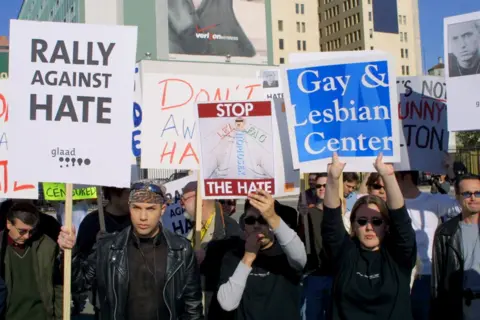 Getty Images
Getty Images
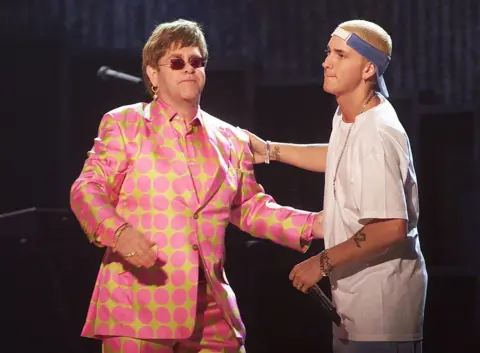 Getty Images
Getty Images
Mathers himself is a dichotomy, with Shady’s antics counter-balanced by his thought-provoking raps as Eminem.
The track best demonstrating Eminem’s self-awareness is Stan.
Its groundbreaking narrative storytelling follows an obsessed Shady fan who kills himself and his girlfriend when Eminem does not reply to his letters. The track ends with Eminem’s apologetic response for the delay.
Dr Phoenix Andrews, a writer on fandoms, says the track was prescient in understanding today’s intense internet followings and portraying the pressure and responsibility within artist/fan relationships.
“Men talking about mental health was much rarer then and is still stigmatised,” Dr Andrew says. “Eminem reaching out to Stan and not mocking him was exceptional at the time.”
Allow Google YouTube content?
The conflicts of Eminem’s personas have had other unintended consequences.
The portrayal of the angry white male through Slim Shady has arguably been co-opted by US alt-right and white nationalist movements.
“Eminem is often mentioned in far-right online spaces,” adds Sam de Boise, a musicology lecturer specialising in radicalisation at Sweden’s Örebro University.
“They also identify with his underdog status – a lot of these young men see themselves as lacking social power,” he says.
A changing legacy?
Today, Mathers, now the best-selling rapper of all-time, walks a tightrope – fighting to control Slim Shady’s unpredictable legacy while reconciling his own identity.
At the 2017 BET Awards, he openly distanced himself from Trump supporters with an eviscerating rap.
The repoliticisation contrasted with a decade of his pop-rap hits like Not Afraid and collaborations with Rihanna, including Love the Way You Lie and The Monster, often using his recovery from drug addiction as narrative inspiration – helping to soften his image for a new generation.
As time progressed, the rapper’s attempts to return to his old style have not always been well received by Gen Z audiences, some calling for him to be cancelled.
But unlike the early 2000s, Eminem responded to online criticism, apologising for a homophobic slur against Tyler, the Creator.
These incidents highlight evolving public opinion, especially in today’s online cancel culture. Pew Research Center found a generational divide: older audiences see it as censoring artistic freedom, while younger people view it as essential for accountability.
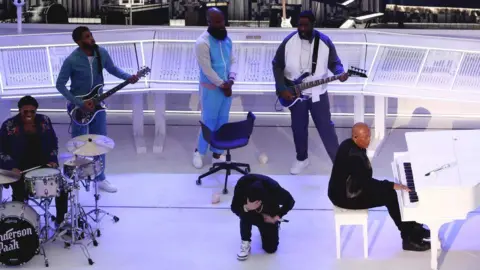 Getty Images
Getty Images
Despite controversies, Eminem’s last two albums have surpassed three billion streams on Spotify, with 10 tracks exceeding a billion streams, equalling Drake and Coldplay.
For freelance culture journalist Kesewaa Browne, Mathers still holds a place in hip-hop, but not as prominently as before.
While his unique lyricism is still widely appreciated, he isn’t often mentioned in contemporary rap discussions dominated by Grime, Drake, and socially conscious rappers like Kendrick Lamar.
So, is killing off Slim Shady an effort to secure his legacy? “I think it might be,” says Browne.
“He hasn’t hidden his contempt for the current state of the genre. Perhaps he wants to show he’s still got it.
“Some fans have grown up with Slim Shady. But if it sounds like his early noughties, could that be alienating to some?”
Allow Twitter content?
It’s a risk Eminem teased, suggesting the new album’s single Houdini would make his career “disappear”.
The playful nostalgic video, released on Friday, shows present-day Eminem trying to stop his 2002 incarnation of Shady, who has time travelled to the present, from grabbing the mic.
A battle eventually sees a hybrid version form – potentially ready to unleash a new wave of controversy.
Speaking about his childhood to Radio 1 in 1999, he told Jo Whiley: “I used to make up my own heroes and my own villains, but my heroes would always die.”
Which is Shady? It depends who you ask, and when.
